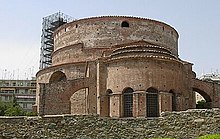Rotunda (Thessaloniki)
The rotunda ( Greek Ροτόντα Rotónda ) of Galerius in Thessaloniki , later named Άγιος Γεώργιος after the St. George's Chapel opposite , is a domed structure from Roman times that was built in connection with the Galerius Arch . The building located north of Egnatia Street in the east of the city center, also known as the Georg Rotunda , was named by travelers in the 18th and 19th centuries. In the Turkish times it was called Eski Metropol (Old Metropolie). The rotunda is part of the world cultural heritage of the " early Christian and Byzantine buildings in Thessaloniki ". The building has been used as a church (with interruption) since 326 and can therefore be considered the oldest church in the world.

construction

The rotunda , erected in 306 AD as a cult building for the Kabiren or Zeus or as a mausoleum for the tetrarch Galerius , the inner walls of which were originally covered with a pseudo-marble architecture, has a height of 29.80 meters interrupted by an oculus Brick masonry dome with an inner diameter of 24.50 meters, which at the time of construction was the world's largest brick dome. The thickness of the walls pierced by six windows is 6.30 meters.
use
The building was probably converted in the 4th century under Emperor Theodosius I or Constantine I into a Christian church dedicated to the incorporeal (Asomaton; να unterς των Ασωμάτων), which at times served as a metropolitan church, and decorated with mosaics . In 1590 the rotunda was converted into a mosque ( Hortaç Efendi Camii ) and a minaret was added to the building; Valuables and icons were brought to the small St. George's Chapel west of the Rotonda. When Thessaloniki came under Greek rule in 1912, the rotunda became a church again, but in 1917 it became the Macedonian Museum. The minaret was the only one left in Thessaloniki. The building was damaged by an earthquake in 1978 and has been restored since then. The restoration work inside the building is still ongoing. In 1999 the rotunda was reopened as a museum monument, although the Greek Orthodox Church still claims the building. In the east apse there is again a consecrated altar.
Mosaics
The rotunda mosaics are considered to be the oldest wall mosaics in the Christian East. Some of them are purely ornamental (octagons with birds and fish in the south-east niche, intersecting circles in the west niche, carpet-like in the south niche). The dome mosaics on a gold background are divided into three zones: 15 preserved martyr figures in wide robes (including Ananias, Romanos, Aristarchus, Kyrillos, Basiliskos, Leon, Philipp, Priskos, Kosmas and Damian) in front of seated peacocks of animated pseudo-architecture with acanthus leaves and ornamental strips, fragmentarily preserved Apostles and Angels and Triumphant Christ (not preserved).
See also
- List of Roman domes
- List of the largest domes of their time
- List of the oldest churches in the world
literature
- E. Hébrard: Les travaux du Service Archéologique de l'Armée d'Orient à l'arc de triomphe de Galère et l'église de St. Georges à Salonique. In: Bulletin de Correspondance Hellénique 44 (1920), 15-40.
- Ejnar Dyggve : Recherches sur le palais impérial de Thessalonique. In: Studia Orientalia Ioanni Pedersen dedicata , Copenhagen 1953, 59–70.
- G. Theocharidis: Ο ναός των Ασωμάτων και η Rotonda του Αγίου Γεωργίου Θεσσαλονίκης. In: Ελληνικά 13 (1954), 24-70.
- H. Torp: Mosaikkene i St. Georgs rotunda i Thessaloniki. Et hovedverk i tidlig-Byzantinisk art. Oslo 1963.
- E. Kleinbauer: The Original Name and Function of Hagios Georgios at Thessaloniki. In: Cahiers Archéologiques 22 (1972), 55-60.
- E. Kleinbauer: The Iconography and the Date of the Mosaics of the Rotunda of Hagios Georgios, Thessaloniki. In: Viator. Medieval and Renaissance Studies 3 (1972), 27-107.
- G. Velenis: Some observations on the original form of the Rotunda in Thessaloniki. In: Balkan Studies 15 (1974), 298-307.
- Th. Pazaras: Η Ροτόντα του Αγίου Γεωργίου στη Θεσσαλονίκη. Thessaloniki 1985.
- B. Kiilerich & H. Torp, The Rotunda in Thessaloniki and its Mosaics, Athens 2017.
Web links
Individual evidence
- ↑ UNESCO World Heritage List - Paleochristian and Byzantine Monuments of Thessalonika (English)
- ↑ a b c K. Kourkoutidou-Nikolaidou, A. Tourta: walks through the Byzantine Thessaloniki. Editions Kapon, Athens 1997, ISBN 960-7254-48-1 , p. 56.
- ^ Friederike Kyrieleis: Art monuments in Greece - a picture handbook. The mainland. Deutscher Kunstverlag, Munich / Berlin 1982, ISBN 3-422-00375-4 , p. 449.
- ↑ Apostolos Papajannopoulos: monuments of Thessaloniki. Rekos, Thessaloniki 1983, p. 36
- ↑ Ioannis Pscharis: The Salonica (Thessaloniki) earthquake of June 20, 1978. California Institute of Technology 1978, p 10 (English, PDF) ( Memento of 19 July 2011 at the Internet Archive ).
- ↑ On the peacock motif: Paul Huber: Athos - life, faith, art. 2nd Edition. Artemis, Zurich 1982, ISBN 3-7611-0041-8 , pp. 387-388.
Coordinates: 40 ° 38 ′ 0 ″ N , 22 ° 57 ′ 10.6 ″ E






